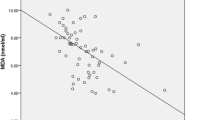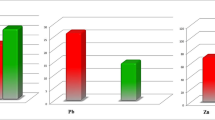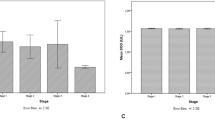Abstract
Behçet’s disease (BD) is a chronic, progressive disorder that affects many systems of the body including the eye. The aim of this study was to assess whether the increase in oxidative stress in the affected tissues is reflected by lipid peroxidation and to check for alterations in antioxidants and antioxidant enzyme activities in patients with BD. Erythrocyte antioxidant potential (AOP), glutathione (GSH) and GSH-dependent enzymes (glutathione peroxidase (GSH-Px), glutathione reductase (GRD) and glutathione-S-transferase (GST), catalase (CAT), Cu–Zn superoxide dismutase (Cu–Zn SOD) activities, malondialdehyde (MDA) and some trace elements (zinc, Zn; copper, Cu; manganese, Mn) levels in men with BD. Erythrocyte CAT, GSH-Px activities, MDA, GSH, AOP and serum Zn values were significantly lower in patients with BD than in the control group. However, erythrocyte Cu–Zn SOD, GRD activities, erythrocyte sedimentation rate (ESR), serum C-reactive protein (CRP) and Cu values were significantly higher in patients with BD than in the control group, but GST activity and serum Mn values were unchanged. In conclusion, our results confirm the presence of oxidative stress in patients with BD and suggest that the severity of BD may arise from impaired antioxidant mechanisms. Therapy with antioxidants may lead to the increase in the antioxidant defense system and thus improvement in clinical symptoms.
Similar content being viewed by others
Abbreviations
- AOP:
-
antioxidant potential
- BD:
-
Behçet’s disease
- CAT:
-
catalase
- CRP:
-
C-reactive protein
- Cu–Zn SOD:
-
Cu–Zn superoxide dismutase
- ESR:
-
erythrocyte sedimentation rate
- DTNB:
-
5, 5′-dithiobis (2-nitrobenzoic acid)
- GSH:
-
reduced glutathione
- GSH-Px:
-
glutathione peroxidase
- GRD:
-
glutathione reductase
- H2O2 :
-
hydrogen peroxide
- MDA:
-
malondialdehyde
- NADPH:
-
reduced nicotinamide adenine dinucleotide phosphate
- NADP+ :
-
oxidized nicotinamide adenine dinucleotide phosphate
- NBT:
-
nitroblue tetrazolium
- NO:
-
nitric oxide
- \( {\text{O}}^{{\raise0.145em\hbox{${\scriptscriptstyle \bullet}$} - }}_{2} \) :
-
superoxide anion radical
- \( ^{\raise0.145em\hbox{${\scriptscriptstyle \bullet}$}} {\text{OH}}^{ - } \) :
-
hydroxyl radicals
- ONOO− :
-
peroxynitrite
- RNS:
-
reactive nitrogen species
- ROS:
-
reactive oxygen species
- TBA:
-
thiobarbituric acid
- TBARS:
-
total thiobarbituric acid-reactive substances
References
Taysi S, Kocer I, Memisogullari R, Kiziltunc A (2002) Serum oxidant/antioxidant status in serum of patients with Behçet’s disease. Ann Clin Lab Sci 32:377–382
Behçet H (1937) Uber residivietende apththose, durch ein virus verursachte geschwura am mund, am auge und an den genitalien. Dermatol Wochenschr 105:1152–1157
Watanabe K, Ohashi Y (1984) Natural killer cells activity in patients with Behcet’s disease. Am J Ophthalmol 98:813–814
Nussenblatt RB, Whitcup SM, Palestine AG (1996) Uveitis: fundamentals and clinical practice. Mosby, St. Louis, pp 334–353
Sakane T, Takeno M, Suzuki N, Inaba G (1999) Behçet’s disease. New Engl J Med 341:1284–1291
El-Ageb EM, Al-Maini MH, Al-Shukaily AK, Al-Farsi Y, Richens ER (2002) Clinical features of Behçet’s disease in patients in the Sultanate of Oman; the significance of the antiphospholipid antibodies? Rheumatol Int 21:176–181
Akkus I, Kalak S, Vural H, Caglayan O, Menekse E, Can G, Durmus B (1996) Leukocyte lipid peroxidation, superoxide dismutase, glutathione peroxidase and serum and leukocyte vitamin C levels of patients with type II diabetes mellitus. Clin Chim Acta 244:221–227
Taysi S, Polat F, Gul M, Sari RA, Bakan E (2002) Lipid peroxidation, some extracellular antioxidants and antioxidant enzymes in serum of patients with rheumatoid arthritis. Rheumatol Int 21:200–204
Taysi S, Gul M, Sari RA, Akcay F, Bakan N (2002) Serum oxidant/antioxidant status in serum of patients with systemic lupus erythematosus. Clin Chem Lab Med 40:684–688
Yagi K (1984) Increased lipid peroxides initiates atherogenesis. Bio Essays 1:58–60
Clemens MR, Waller HD (1987) Lipid peroxidation in erythrocytes. Chem Phys Lipids 45:251–268
Kose K, Yazici C, Cambay N, Ascioglu O, Dogan P (2002) Lipid peroxidation and erythrocyte antioxidant enzymes in patients with Behçet’s disease. Tohoku J Exp Med 197:9–16
Aydin E, Sogut S, Ozyurt H, Ozugurlu F, Akyol A (2004) Comparison of serum nitric oxide, malondialdehyde levels, and antioxidant enzyme activities in Behçet’s disease with and without ocular disease. Ophthalmic Res 36:177–182
Gul M, Kutay FZ, Temocin S, Hanninen O (2000) Cellular and clinical implications of glutathione. Indian J Exp Biol 38:625–634
Saglam K, Serce AF, Yilmaz MI, Bulucu F, Aydin A, Akay C, Sayal A (2002) Trace elements and antioxidant enzymes in Behçet’s disease. Rheumatol Int 22:93–96
Taysi S, Gülçin I, Sari RA, Kuskay S, Bakan N (2003) Trace elements and disease activity score in patients with rheumatoid arthritis. Pain Clin 4:435–439
International Study Group for Behçet’s Disease (1990) Criteria for diagnosis of Behçet’s disease. Lancet 335:1078–1080
Durak I, Karabacak HI, Buyukkocak S, Cimen MY, Kacmaz M, Omeroglu E, Ozturk HS (1998) Impaired antioxidant defense system in the kidney tissues from rabbits treated with cyclosporine. Protective effects of vitamins E and C. Nephron 78:207–211
Jain SK, McVie R, Duett J, Herbst JJ (1989) Erythrocyte membrane lipid peroxidation and glycosylated hemoglobin in diabetes. Diabetes 38:1539–1543
Sun Y, Oberley LW, Li Y (1988) A simple method for clinical assay of superoxide dismutase. Clin Chem 34:497–500
Paglia DE, Valentina WN (1967) Studies on the quantitative and qualitative characterization of erythrocyte glutathione peroxidase. J Lab Clin Med 70:158–169
Pinto RE, Bartley W (1969) The effect of age and sex on glutathione reductase and glutathione peroxidase activities and on aerobic glutathione oxidation in rat liver homogenates. Biochem J 112:109–115
Sen CK, Marin E, Kretzschmar M, Hänninen O (1992) Skeletal muscle and liver glutathione homeostasis in response to training, exercise, and immobilization. J Appl Physiol 73:1265–1272
Aebi H (1974) Catalase. In: Bergmeyer HU (ed) Methods of enzymatic analysis. Academic, New York, pp 673–678
Tietze (1969) Enzymic method for quantitative determination of nanogram amounts of total and oxidized glutathione: applications to mammalian blood and other tissues. Anal Biochem 27:502–522
Young IS, Woodside JV (2001) Antioxidants in health and disease. J Clin Pathol 54:176–186
Kose K, Dogan P, Ascioglu M, Erkilic K, Ascioglu O (1995) Oxidative stress and antioxidant defenses in plasma of patients with Behcet’s disease. Tohoku J Exp Med 176:239–248
Kose K, Yazici C, Assioglu O (2001) The evaluation of lipid peroxidation and adenosine deaminase activity in patients with Behcet’s disease. Clin Biochem 34:125–129
Dincer Y, Alademir Z, Hamuryudan V, Fresko I, Akcay T (2002) Superoxide dismutase activity and glutathione system in erythrocytes of men with Behcet’s disease. Tohoku J Exp Med 198:191–195
Memisogullari R, Taysi S, Bakan E, Capoglu I (2003) Antioxidant status and lipid peroxidation in type II diabetes mellitus. Cell Biochem Funct 21:291–296
Taysi S, Akcay F, Uslu C, Dogru Y, Gulcin I (2003) Trace elements and some extracellular antioxidant proteins levels in serum of patients with laryngeal cancer. Biol Trace Elem Res 91:11–18
Author information
Authors and Affiliations
Corresponding author
Rights and permissions
About this article
Cite this article
Taysi, S., Demircan, B., Akdeniz, N. et al. Oxidant/antioxidant status in men with Behçet’s disease. Clin Rheumatol 26, 418–422 (2007). https://doi.org/10.1007/s10067-006-0513-x
Received:
Revised:
Accepted:
Published:
Issue Date:
DOI: https://doi.org/10.1007/s10067-006-0513-x




